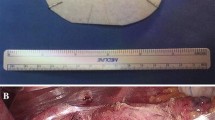Abstract
Introduction
Laparoscopic hiatal hernia repair has a better chance of success if the hiatus is closed without tension. This study attempts to answer the following questions: (1) What is the rate of hiatal hernia recurrence in patients who undergo hiatal closure with diaphragmatic relaxing incisions? (2) Can biologic mesh be safely substituted for synthetic mesh as coverage of the relaxing incisions?
Methods
We identified all patients who underwent laparoscopic hiatal hernia repair at our institution between 2007 and 2013 and reviewed their clinical records. Radiologic recurrence was identified by an experienced radiologist and defined as the presence of any abdominal contents located above the diaphragm on esophagram. Clinical recurrence was defined as little or no improvement in symptoms, the development of a new symptom, or the need for medical, endoscopic, or surgical treatment of postoperative symptoms.
Results
A minimum of 6 months of radiologic and clinical follow-up was available for 146 (40 %) patients, including 16 with relaxing incisions. There were 66 (45 %) recurrent hernias detected on esophagram. There was no difference in the rate of recurrent hiatal hernia among the three groups: Primary closure of the hiatus (21/36 [58 %]), primary closure with biologic mesh reinforcement (36/94 [38 %]), and relaxing incision with biologic mesh reinforcement (9/16 [56 %]; p = 0.428). Two reoperations were performed on patients who underwent left relaxing incisions and developed symptomatic diaphragmatic hernias through the left relaxing incisions. There were no complications associated with use of biologic mesh at the hiatus.
Conclusions
Rate of recurrent hiatal hernia is similar between patients who undergo diaphragmatic relaxing incisions and patients who undergo primary hiatal closure. Relaxing incisions can be safely performed on either crus; however, biologic mesh should not be used to patch a left-sided relaxing incision due to the risk of developing a diaphragmatic hernia.




Similar content being viewed by others
References
DeMeester SR (2013) Laparoscopic paraesophageal hernia repair: critical steps and adjunct techniques to minimize recurrence. Surg Laparosc Endosc Percutan Tech 23:429–435
Oelschlager BK, Pellegrini CA, Hunter JG, Brunt ML, Soper NJ, Sheppard BC, Polissar NL, Neradilek MB, Mitsumori LM, Rohrmann CA, Swanstrom LL (2011) Biologic prosthesis to prevent recurrence after laparoscopic paraesophageal hernia repair: long-term follow-up from a multicenter, prospective, randomized trial. J Am Coll Surg 213:461–468
De Moor V, Zalcman M, Delhaye M, El Nakadi I (2012) Complications of mesh repair in hiatal surgery: about 3 cases and review of the literature. Surg Laparosc Endosc Percutan Tech 22:e222–e225
Stadlhuber RJ, Sherif AE, Mittal SK, Fitzgibbons RJ Jr, Michael Brunt L, Hunter JG, Demeester TR, Swanstrom LL, Daniel Smith C, Filipi CJ (2009) Mesh complications after prosthetic reinforcement of hiatal closure: a 28-case series. Surg Endosc 23:1219–1226
Tatum RP, Shalhub S, Oelschlager BK, Pellegrini CA (2008) Complications of PTFE mesh at the diaphragmatic hiatus. J Gastrointest Surg Off J Soc Surg Aliment Tract 12:953–957
Bradley DD, Louie BE, Farivar AS, Wilshire CL, Baik PU, Aye RW (2015) Assessment and reduction of diaphragmatic tension during hiatal hernia repair. Surg Endosc 29:796–804
Huntington TR (1997) Laparoscopic mesh repair of the esophageal hiatus. J Am Coll Surg 184:399–400
Wassenaar EB, Mier F, Sinan H, Petersen RP, Martin AV, Pellegrini CA, Oelschlager BK (2012) The safety of biologic mesh for laparoscopic repair of large, complicated hiatal hernia. Surg Endosc 26:1390–1396
Alicuben ET, Worrell SG, DeMeester SR (2014) Impact of crural relaxing incisions, Collis gastroplasty, and non-cross-linked human dermal mesh crural reinforcement on early hiatal hernia recurrence rates. J Am Coll Surg 219:988–992
Oelschlager BK, Barreca M, Chang L, Oleynikov D, Pellegrini CA (2003) Clinical and pathologic response of Barrett’s esophagus to laparoscopic antireflux surgery. Ann Surg 238:458–464 discussion 464–456
Lal DR, Pellegrini CA, Oelschlager BK (2005) Laparoscopic repair of paraesophageal hernia. Surg Clin N Am 85:105–118
Dallemagne B, Kohnen L, Perretta S, Weerts J, Markiewicz S, Jehaes C (2011) Laparoscopic repair of paraesophageal hernia. Long-term follow-up reveals good clinical outcome despite high radiological recurrence rate. Ann Surg 253:291–296
Hashemi M, Peters JH, DeMeester TR, Huprich JE, Quek M, Hagen JA, Crookes PF, Theisen J, DeMeester SR, Sillin LF, Bremner CG (2000) Laparoscopic repair of large type III hiatal hernia: objective followup reveals high recurrence rate. J Am Coll Surg 190:553–560 discussion 560–551
Oelschlager BK, Petersen RP, Brunt LM, Soper NJ, Sheppard BC, Mitsumori L, Rohrmann C, Swanstrom LL, Pellegrini CA (2012) Laparoscopic paraesophageal hernia repair: defining long-term clinical and anatomic outcomes. J Gastrointest Surg Off J Soc Surg Aliment Tract 16:453–459
Author information
Authors and Affiliations
Corresponding author
Ethics declarations
Disclosures
Dr. Crespin, Yates, Martin and Pellegrini, have nothing to disclose. Dr. Oelschlager gave educational talks for Cook.
Rights and permissions
About this article
Cite this article
Crespin, O.M., Yates, R.B., Martin, A.V. et al. The use of crural relaxing incisions with biologic mesh reinforcement during laparoscopic repair of complex hiatal hernias. Surg Endosc 30, 2179–2185 (2016). https://doi.org/10.1007/s00464-015-4522-1
Received:
Accepted:
Published:
Issue Date:
DOI: https://doi.org/10.1007/s00464-015-4522-1




